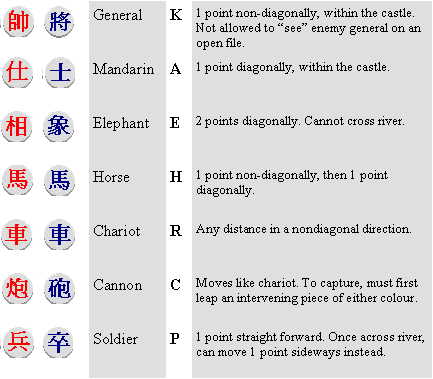|
3 Dimensional Chinese Chess Set |
|
|
Introduction of Chinese Chess Game |
|
|
|
|
|
In all cases except that of the cannon, pieces move when capturing just as they do when
not capturing. General. One square in any non-diagonal direction within
the castle. Cannot move outside the castle. In addition, the general has the theoretical power of moving like a rook along
a file from his own castle to the enemy castle, to capture the opposing general. Therefore it is illegal to make any move
that leaves your own general on an open file opposite the opposing general, because to do so would be to move into check.
Mandarin. Elephant. Two points in any diagonal direction. It must move two points, and cannot leap another piece of either colour. Cannot cross the river. An elephant can thus reach only seven points on the board. Horse. One point in any non-diagonal direction, followed by one point in a diagonal direction, so that it ends two points away from where it started. This is similar to the knight move in Western chess, except that the move is blocked by any piece occupying the point at the "elbow" of the move. Hence it is important to remember that the non-diagonal part of the move comes first. Chariot. Any number of points in any non-diagonal direction. Cannot leap. This is just like the rook move in Western chess. Cannon. When not capturing, moves just like the chariot. When capturing, must leap a single piece of either colour before proceeding to the point occupied by the target piece. This intervening piece is called a screen. Soldier. One point straight forward. After it reaches the opposite river bank, can move one point forward or directly sideways. Never moves diagonally or backward. No further promotion is gained when a soldier reaches the farthest rank of the board.
|
|



 , or sometimes a more elaborate motto.
, or sometimes a more elaborate motto.